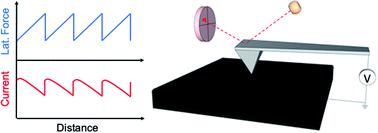当前位置:
X-MOL 学术
›
Nanoscale Adv.
›
论文详情
Our official English website, www.x-mol.net, welcomes your feedback! (Note: you will need to create a separate account there.)
Insights into dynamic sliding contacts from conductive atomic force microscopy
Nanoscale Advances ( IF 4.7 ) Pub Date : 2020-07-24 , DOI: 10.1039/d0na00414f Nicholas Chan 1 , Mohammad R Vazirisereshk 2 , Ashlie Martini 2 , Philip Egberts 1
Nanoscale Advances ( IF 4.7 ) Pub Date : 2020-07-24 , DOI: 10.1039/d0na00414f Nicholas Chan 1 , Mohammad R Vazirisereshk 2 , Ashlie Martini 2 , Philip Egberts 1
Affiliation

|
Friction in nanoscale contacts is determined by the size and structure of the interface that is hidden between the contacting bodies. One approach to investigating the origins of friction is to measure electrical conductivity as a proxy for contact size and structure. However, the relationships between contact, friction and conductivity are not fully understood, limiting the usefulness of such measurements for interpreting dynamic sliding properties. Here, atomic force microscopy (AFM) was used to simultaneously acquire lattice resolution images of the lateral force and current flow through the tip–sample contact formed between a highly oriented pyrolytic graphite (HOPG) sample and a conductive diamond AFM probe to explore the underlying mechanisms and correlations between friction and conductivity. Both current and lateral force exhibited fluctuations corresponding to the periodicity of the HOPG lattice. Unexpectedly, while lateral force increased during stick events of atomic stick-slip, the current decreased exponentially. Molecular dynamics (MD) simulations of a simple model system reproduced these trends and showed that the origin of the inverse correlation between current and lateral force during atomic stick-slip was atom–atom distance across the contact. The simulations further demonstrated transitions between crystallographic orientation during slip events were reflected in both lateral force and current. These results confirm that the correlation between conduction and atom–atom distance previously proposed for stationary contacts can be extended to sliding contacts in the stick-slip regime.
中文翻译:

从导电原子力显微镜看动态滑动接触
纳米级接触中的摩擦力由隐藏在接触体之间的界面的尺寸和结构决定。研究摩擦起源的一种方法是测量电导率作为接触尺寸和结构的代表。然而,接触、摩擦和电导率之间的关系尚未完全了解,这限制了此类测量在解释动态滑动特性方面的有用性。在这里,原子力显微镜 (AFM) 用于同时获取横向力和电流的晶格分辨率图像,通过在高度取向的热解石墨 (HOPG) 样品和导电金刚石 AFM 探针之间形成的尖端-样品接触来探索潜在的摩擦力和电导率之间的机制和相关性。电流和横向力都表现出与 HOPG 晶格的周期性相对应的波动。出乎意料的是,虽然在原子粘滑的粘滞事件中横向力增加,但电流呈指数下降。一个简单模型系统的分子动力学 (MD) 模拟再现了这些趋势,并表明原子粘滑过程中电流和横向力之间的负相关的起源是接触处的原子-原子距离。模拟进一步证明了滑动事件期间晶体取向之间的转变反映在横向力和电流中。这些结果证实,先前为静止接触提出的传导和原子-原子距离之间的相关性可以扩展到粘滑状态下的滑动接触。
更新日期:2020-09-16
中文翻译:

从导电原子力显微镜看动态滑动接触
纳米级接触中的摩擦力由隐藏在接触体之间的界面的尺寸和结构决定。研究摩擦起源的一种方法是测量电导率作为接触尺寸和结构的代表。然而,接触、摩擦和电导率之间的关系尚未完全了解,这限制了此类测量在解释动态滑动特性方面的有用性。在这里,原子力显微镜 (AFM) 用于同时获取横向力和电流的晶格分辨率图像,通过在高度取向的热解石墨 (HOPG) 样品和导电金刚石 AFM 探针之间形成的尖端-样品接触来探索潜在的摩擦力和电导率之间的机制和相关性。电流和横向力都表现出与 HOPG 晶格的周期性相对应的波动。出乎意料的是,虽然在原子粘滑的粘滞事件中横向力增加,但电流呈指数下降。一个简单模型系统的分子动力学 (MD) 模拟再现了这些趋势,并表明原子粘滑过程中电流和横向力之间的负相关的起源是接触处的原子-原子距离。模拟进一步证明了滑动事件期间晶体取向之间的转变反映在横向力和电流中。这些结果证实,先前为静止接触提出的传导和原子-原子距离之间的相关性可以扩展到粘滑状态下的滑动接触。



























 京公网安备 11010802027423号
京公网安备 11010802027423号